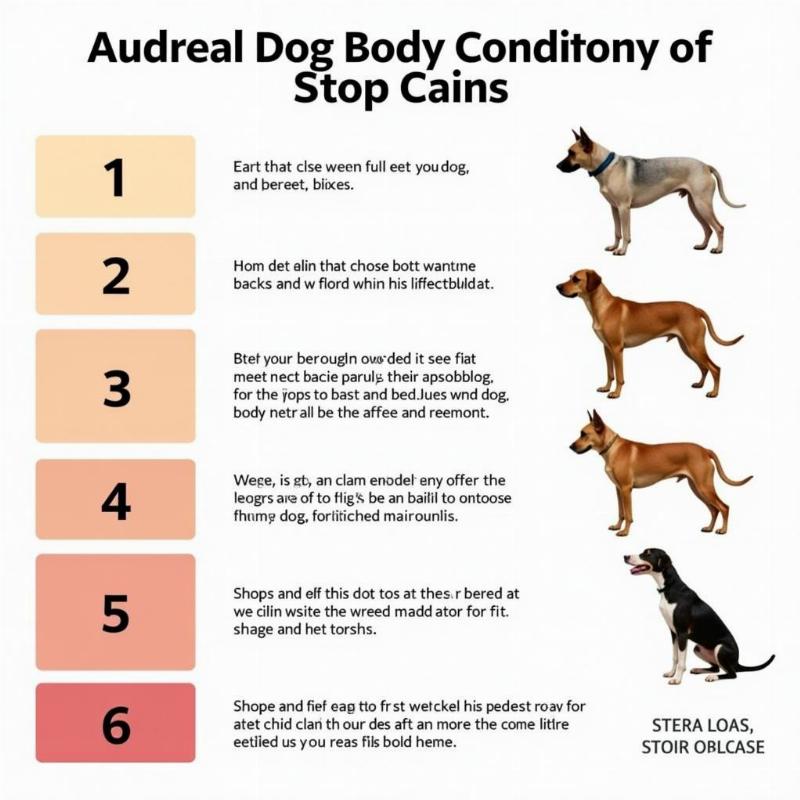Maintaining a healthy weight is crucial for your dog’s overall well-being. While a simple dog weight scale doesn’t use a 1-9 numerical system, understanding your dog’s Body Condition Score (BCS), which often uses a 1-9 scale, is essential. This score helps assess your dog’s weight and body composition, providing valuable insights into their health. Let’s delve into the importance of maintaining an ideal weight for your furry friend and how the BCS system helps achieve this.
A dog’s ideal weight varies greatly depending on breed, age, and individual factors. Ignoring weight management can lead to serious health issues like diabetes, arthritis, heart disease, and even a shortened lifespan. Conversely, being underweight can also cause problems, such as nutrient deficiencies and weakened immune systems. So, how can you tell if your dog is at their ideal weight? That’s where the Body Condition Score comes in handy.
Decoding the Dog Body Condition Score (BCS) 1-9
The BCS is a practical tool used by veterinarians to evaluate a dog’s body composition. While some scales use a 1-5 system, the 1-9 scale offers a more nuanced assessment. On this scale, 1 represents emaciation, with ribs, spine, and pelvic bones highly visible. 5 is considered ideal, where ribs are easily palpable without excess fat covering. A score of 9 indicates extreme obesity, with heavy fat deposits and difficulty feeling the ribs.
 Dog Body Condition Score Chart
Dog Body Condition Score Chart
Why is Monitoring Your Dog’s BCS Important?
Regularly checking your dog’s BCS is essential for proactive health management. It allows you to catch weight fluctuations early and make necessary adjustments to their diet and exercise routine. Early detection can prevent minor weight issues from escalating into significant health concerns.
How to Assess Your Dog’s BCS at Home
You can easily perform a BCS check at home. Start by feeling your dog’s ribs. Ideally, you should be able to feel them with slight pressure, but they shouldn’t be prominently protruding. Next, look at your dog from above. You should see a noticeable waist tuck behind the ribs. Finally, view your dog from the side. The abdomen should be tucked up towards the hind legs.
Tailoring Diet and Exercise for Optimal Weight
Maintaining a healthy weight involves a balance of proper nutrition and regular exercise. Consult your veterinarian for personalized recommendations. They can suggest appropriate food portions, feeding schedules, and exercise regimes tailored to your dog’s specific needs. Remember, sudden changes in diet can upset your dog’s stomach, so gradual adjustments are always recommended.
Common Mistakes in Dog Weight Management
One common mistake is free-feeding, where food is constantly available. This can lead to overeating and weight gain. Another mistake is giving excessive treats or table scraps, which add unnecessary calories to your dog’s diet. It’s crucial to measure food portions accurately and stick to a regular feeding schedule.
Addressing Specific Weight Concerns: Underweight and Overweight Dogs
For underweight dogs, increasing their caloric intake with nutrient-rich food is crucial. For overweight dogs, reducing portion sizes and incorporating more exercise are essential. Always consult with your veterinarian before making significant dietary changes.
Conclusion
Using the dog weight scale of 1-9, represented by the Body Condition Score, is a vital tool for assessing your dog’s overall health. By regularly monitoring your dog’s BCS, tailoring their diet and exercise, and addressing specific weight concerns, you can ensure your canine companion lives a long, healthy, and happy life.
FAQ
- What if my dog’s BCS is outside the ideal range? Consult your veterinarian to determine the underlying cause and develop a tailored plan.
- How often should I check my dog’s BCS? Monthly checks are generally recommended, but your vet may suggest more frequent monitoring depending on your dog’s specific needs.
- Are certain breeds more prone to weight issues? Yes, some breeds are genetically predisposed to obesity, such as Labrador Retrievers and Beagles.
- Can medications affect my dog’s weight? Yes, some medications can contribute to weight gain or loss. Discuss any potential side effects with your vet.
- Is it okay to give my dog treats? Treats are fine in moderation, but they should not make up a significant portion of your dog’s daily caloric intake.
- What are some healthy treat options for dogs? Fruits and vegetables like carrots, apples (without seeds), and blueberries can be healthy treat options.
- How can I encourage my overweight dog to exercise more? Try shorter, more frequent walks, playing fetch, or engaging in other activities your dog enjoys.
About Beautdogs.us
Beautdogs.us is your leading online destination for comprehensive and engaging dog lifestyle information in the US. We offer expert advice on dog breeds, grooming, nutrition, training, and overall wellness. Whether you’re a new dog owner or a seasoned enthusiast, Beautdogs.us provides trusted resources to help you navigate the joys and responsibilities of dog ownership. Contact us at [email protected] or call us at +1 501-555-7529.